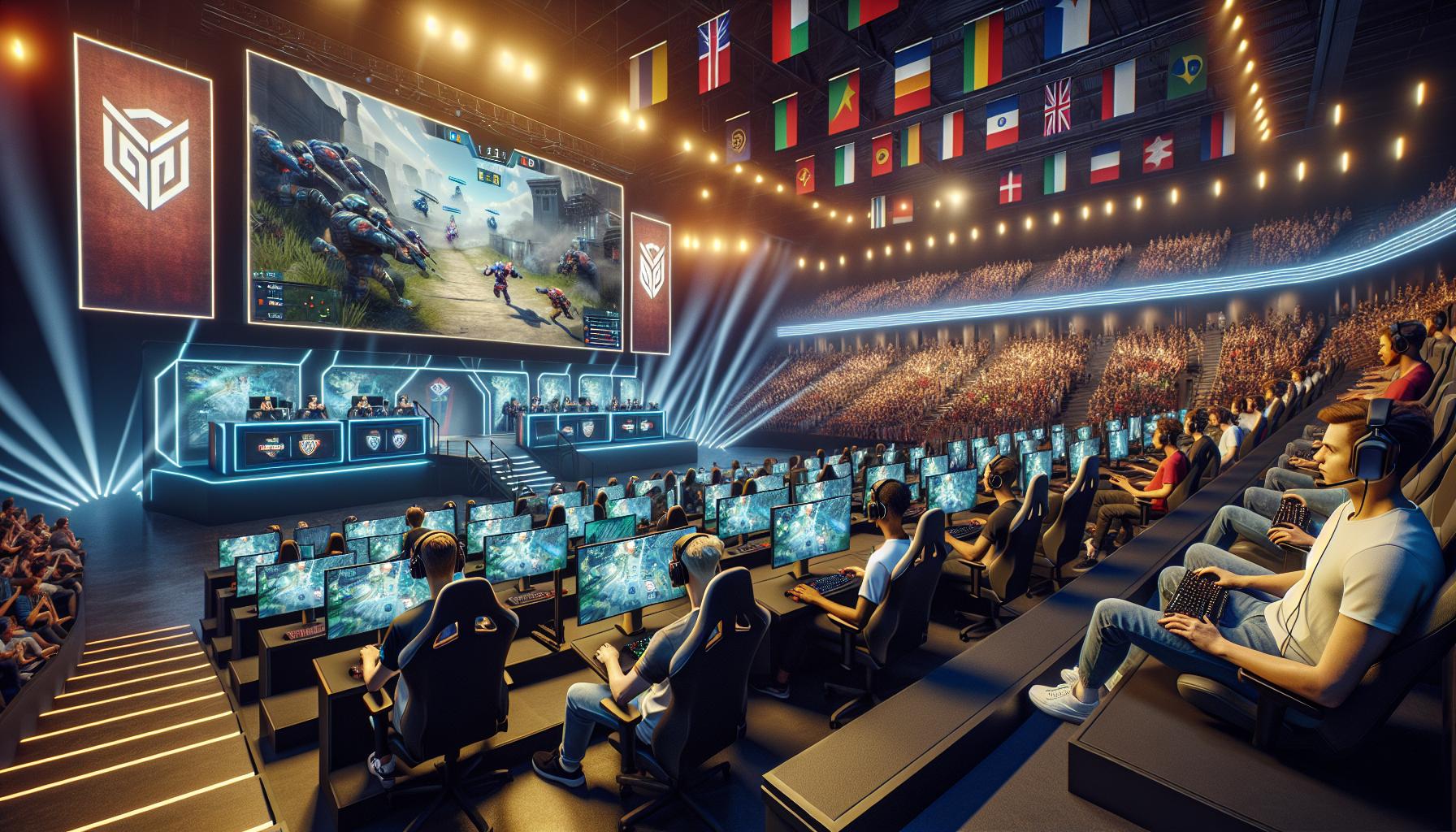Key Takeaways
- Rapid Growth of Esports: The global esports market is projected to reach $1.8 billion in revenue by 2023, driven by sponsorships, advertising, and ticket sales, reflecting its transformation into a mainstream entertainment option.
- Massive Audience Engagement: Approximately 500 million esports enthusiasts are worldwide, with significant engagement from Gen Z and Millennials, indicating a shifting preference away from traditional sports.
- Top Esports Titles: Popular games such as League of Legends, Dota 2, and Counter-Strike: Global Offensive dominate viewership, often attracting millions of concurrent viewers during major tournaments.
- Diverse Sponsorship Landscape: Major brands like Coca-Cola, Intel, and Red Bull are heavily investing in esports, contributing to job creation and showcasing the industry’s financial potential.
- Technological Innovations: Advances in streaming services, virtual reality, and blockchain technology enhance the esports experience, making it more interactive and accessible to fans.
- Future Growth Areas: Expected growth in areas like collegiate esports, mobile gaming, and regional leagues hints at the increasing institutional support and expanding audience for competitive gaming.
Esports has rapidly transformed from a niche hobby into a global phenomenon, captivating millions of fans and players alike. With its explosive growth, understanding the facts and figures behind this digital arena is crucial for anyone interested in the gaming industry. The rise of competitive gaming has not only changed how people view sports but also created lucrative opportunities for players, teams, and sponsors.
From staggering viewership numbers to multi-million dollar tournaments, the statistics surrounding esports reveal a vibrant ecosystem. As traditional sports face challenges in engaging younger audiences, esports offers a fresh alternative that resonates with a tech-savvy generation. Exploring these insights sheds light on the future of entertainment and the evolving landscape of competition.
Esports Facts And Figures
Esports represents a rapidly expanding sector within the broader gaming industry. As of 2023, the global esports market is projected to reach approximately $1.8 billion in revenue, driven by sponsorships, advertising, and ticket sales. Major tournaments attract millions of viewers, with platforms like Twitch and YouTube Gaming reporting peak concurrent viewers in the millions during events.
Professional esports players often compete for substantial prize pools. In 2022, the prize pool for The International, a premier Dota 2 tournament, exceeded $40 million, showcasing the financial stakes involved. The growing audience of esports includes around 500 million enthusiasts worldwide, with significant engagement from Gen Z and Millennials, capturing an audience increasingly disinterested in traditional sports.
Various genres dominate the esports landscape, like MOBAs, first-person shooters, and battle royale games. Titles such as League of Legends, Counter-Strike: Global Offensive, and Fortnite lead in terms of popularity and viewership. Tournament structures often feature league play, allowing teams to compete over extended seasons, culminating in championship events.
Sponsorship opportunities are abundant, with companies investing in teams and events to tap into the enthusiastic audience. Brands like Coca-Cola, Intel, and Red Bull actively support esports, reflecting its mainstream acceptance. The rise of collegiate esports further legitimizes the field, providing pathways for students to engage in competitive gaming while pursuing academic goals.
Emphasizing the impact on careers, esports creates roles for players, coaches, analysts, and content creators. Some universities offer degree programs focused on esports management, reinforcing its professional viability. The convergence of technology and entertainment fosters an ecosystem where players and fans experience immersive engagement, enhancing the overall appeal of esports.
Growth Of The Esports Industry

The esports industry has shown remarkable expansion, solidifying its status as a key player in global entertainment. Understanding the financial and audience metrics offers insight into this dynamic sector.
Market Size And Revenue
The global esports market is projected to reach approximately $1.8 billion in revenue by the end of 2023, fueled by diverse sources such as sponsorships, advertising, and ticket sales. Sponsorships account for a significant portion of this revenue, with major brands increasing investments in teams and events. In 2022, the sponsorship market alone was valued at around $1.2 billion. Projections indicate steady growth, with revenues anticipated to surpass $3 billion by 2025.
| Year | Projected Market Revenue (in billion $) |
|---|---|
| 2022 | 1.4 |
| 2023 | 1.8 |
| 2025 | 3.0 |
Global Audience Reach
The global audience for esports continues to expand, with about 500 million enthusiasts worldwide, including active and casual viewers. Engagement is particularly strong among Gen Z and Millennials, who represent a significant portion of the esports demographic. Major platforms like Twitch and YouTube Gaming report millions of peak concurrent viewers during major tournaments, reflecting increased participation levels. For example, The International 2022 drew over 2.5 million peak viewers, underscoring the immense popularity of high-stakes events in the esports calendar.
Major Esports Titles And Their Impact

Various esports titles significantly influence the gaming landscape, attracting vast audiences and shaping competitive gaming’s future.
Top Games By Viewership
League of Legends ranks as the most-viewed esports title, consistently drawing millions during international competitions, such as the World Championship, which peaked at 73 million viewers in 2021. Dota 2 follows closely, with The International attracting over 2.5 million concurrent viewers in 2022. Counter-Strike: Global Offensive maintains strong engagement, with major tournaments like ESL Pro League reporting peak viewership exceeding 1 million. Fortnite, known for its creative gameplay and tournaments, captured 2.3 million viewers during the 2021 Fortnite World Cup. Other notable titles include Apex Legends and VALORANT, establishing substantial followings and significant viewership figures.
Competitive Formats And Tournaments
Esports tournaments typically adopt various competitive formats, including league-based and knockout styles. League of Legends employs a league format through the LCS and LEC, fostering team rivalries across regular seasons. The International Dota 2 features a playoff format that showcases the world’s top teams in thrilling matches. Counter-Strike: Global Offensive often incorporates a mix of group stages and knockout rounds, with events like DreamHack Major allowing teams a chance to demonstrate skill at different levels. Fortnite tournaments utilize both solo and duo formats, providing epic competitions during events like the FNCS. Overall, these formats not only enhance viewer engagement but also amplify the overall excitement surrounding competitive gaming.
Demographics Of Esports Fans

Esports fans represent a diverse group influenced by various factors, including age, gender, and location. Understanding these demographics offers insights into the growth and appeal of esports.
Age And Gender Distribution
Esports attracts a predominantly young audience, with the largest segment aged 18 to 34 years. Research shows that over 60% of esports fans fall within this age range. Males account for approximately 73% of the viewer base, while females comprise about 27%. This gender distribution reflects industry trends and highlights opportunities for brands to engage more female gamers. Notably, Gen Z represents a significant portion, with surveys indicating that about 75% of this generation identifies as esports fans.
Geographical Trends
Esports enjoys a global presence, but trends vary regionally. Asia leads in audience size, accounting for nearly 50% of the global esports community. North America follows, contributing about 25% to the overall viewer count. Europe, with approximately 20%, also shows strong engagement. Countries like China, South Korea, and the United States consistently rank among the top nations for esports viewership, driven by popular titles and well-established leagues. Local events in these regions foster community engagement and bolster fan loyalty, further enhancing the appeal of esports worldwide.
Sponsorship And Investment In Esports
Esports sponsorship and investment showcase the significant financial backing supporting the industry’s growth. Diverse brands recognize the value of engaging with the expanding esports audience.
Key Brands Involved
Numerous prominent brands actively invest in esports. Coca-Cola consistently sponsors major events and teams, enhancing brand recognition among viewers. Intel plays a crucial role by providing hardware for esports competitions, ensuring smooth gameplay and superior performance. Red Bull supports esports athletes and teams, promoting its energy drink to a dynamic audience. Other notable sponsors include Nike, Audi, and McDonald’s, demonstrating the wide-ranging appeal of esports across various industries.
Economic Impact
The economic impact of esports sponsorships and investments is substantial. The global esports market generated approximately $1.8 billion in revenue in 2023, with sponsorships accounting for approximately $1.2 billion. This investment contributes to job creation, such as roles for players, coaches, analysts, and creators. The success of major events, like The International and League of Legends World Championship, drives ticket sales and merchandise revenue, further bolstering the industry’s financial ecosystem. As esports continues its upward trajectory, its economic influence will likely expand within the broader entertainment landscape, reshaping traditional models of sponsorship and engagement.
Future Trends In Esports
Esports continues to evolve rapidly, driven by technological advancements and changing audience dynamics. The following sections detail key innovations and projected growth areas within the industry.
Innovations And Technology
Innovations in technology significantly shape the esports experience. Streaming services enhance viewer engagement with interactive features like real-time statistics and multi-angle camera perspectives. Virtual reality (VR) and augmented reality (AR) platforms offer immersive environments, allowing fans to experience gameplay as if they were part of the action. Artificial intelligence (AI) facilitates opponent analysis and strategy development, improving player performance.
Blockchain technology introduces secure and transparent transaction methods, impacting prize distribution and player contracts. Additionally, mobile gaming advancements expand accessibility, bringing esports to audiences worldwide. These technological breakthroughs promote a deeper connection between players, fans, and content creators.
Predicted Growth Areas
Predicted growth areas in esports include collegiate competitions, mobile gaming, and regional leagues. Educational institutions increasingly adopt esports programs, integrating competitive gaming with academic pursuits, thereby facilitating career pathways for students. Mobile gaming dominates participation rates, with projections indicating over 50% of players engaging through mobile devices by 2025.
Regional leagues provide localized competitions, fostering community involvement and expanding the esports audience base. Integrating wellness and mental health initiatives within esports organizations ensures player longevity and resilience in high-stress environments. These growth areas enhance the sustainability and appeal of esports as a mainstream entertainment avenue.
Esports is Undeniably Reshaping The Landscape of Entertainment And Competition
Esports is undeniably reshaping the landscape of entertainment and competition. With its rapid growth and impressive statistics, it’s clear that esports is here to stay. The increasing viewership and substantial prize pools reflect a thriving ecosystem that attracts both players and sponsors alike.
As technology continues to evolve, so will the opportunities within the esports realm. The integration of innovative features and new gaming formats promises to enhance the audience experience. With a young and engaged demographic driving the industry forward, esports is not just a trend but a significant cultural movement that’s set to redefine how we perceive sports and entertainment in the years to come.